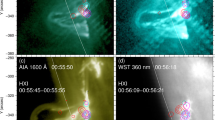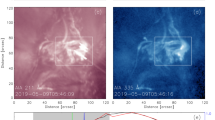Abstract
Quasi-periodic oscillations in soft X-rays (SXR) are not well known due to the instrument limitations, especially the absence of imaging observations of SXR oscillations. We explore the quasi-periodic oscillations of SXR at 3 – 6 keV in a solar flare observed by the Reuven Ramaty High Energy Solar Spectroscopic Imager (RHESSI) on 26 December 2002. This was a B8.1 class event and showed three X-ray sources (S1, S2, and S3) at 3 – 6 keV and two sources (S1 and S2) at 12 – 25 keV. The light curves of the total fluxes display a two-minute oscillation at 3 – 6 keV, but not in the energy bands above 8 keV. To investigate imaging observations of the oscillations, we prepared CLEAN images at seven energy bands between 3 keV and 20 keV with an eight-second integration. The light curves of three sources were analyzed after integrating the flux of each source region. We used the Fourier method to decompose each source light curve into rapidly varying and slowly varying components. The rapidly varying components show seven individual peaks which are well fitted with a sine function. Then we used the wavelet method to analyze the periods in the rapidly varying component of each source. The results show that three sources display damped quasi-periodic oscillations with a similar two-minute period. The damped oscillations timescale varies between 2.5 to 6 minutes. Source S1 oscillates with the same phase as S3, but is almost in anti-phase with S2. Analyzing the flaring images in more detail, we found that these oscillation peaks are well consistent with the appearance of S3, which seems to split from or merge with S2 with a period of two minutes. The flare images with a high cadence of one second at 3 – 6 keV show that source S3 appears with a rapid period of 25 seconds. The two-minute oscillation shows the highest spectral power. Source S3 seems to shift its position along the flare loop with a mean speed of 130 km s−1, which is of the same order as the local sound speed. This connection between the oscillation peaks and emission enhancement appears to be an observational constraint on the emission mechanism at 3 – 6 keV.









Similar content being viewed by others
References
Asai, A., Shimojo, M., Isobe, H., Morimoto, T., Yokoyama, T., Shibasaki, K., Nakajima, H.: 2001, Astrophys. J. Lett. 562, L103. ADS: 2001ApJ...562L.103A . doi: 10.1086/338052 .
Aschwanden, M.J., Benz, A.O.: 1995, Astrophys. J. 438, 997. ADS: 1995ApJ...438..997A . doi: 10.1086/175141 .
Aschwanden, M.J., Benz, A.O., Montello, M.L.: 1994, Astrophys. J. 431, 432. ADS: 1994ApJ...431..432A . doi: 10.1086/174497 .
Aschwanden, M.J., Benz, A.O., Dennis, B.R., Schwartz, R.A.: 1995, Astrophys. J. 455, 347. ADS: 1995ApJ...455..347A . doi: 10.1086/176582 .
Aschwanden, M.J., Bynum, R.M., Kosugi, T., Hudson, H.S., Schwartz, R.A.: 1997, Astrophys. J. 487, 936. ADS: 1997ApJ...487..936A . doi: 10.1086/304633 .
Aschwanden, M.J., Kliem, B., Schwarz, U., Kurths, J., Dennis, B.R., Schwartz, R.A.: 1998, Astrophys. J. 505, 941. ADS: 1998ApJ...505..941A . doi: 10.1086/306200 .
Bogovalov, S.V., Iyudin, A.F., Kotov, Y.D., Dolidze, V.I., Estulin, I.V., Vedrenne, G., Niel, M., Barat, C., Chambon, G., Talon, M.: 1983, Sov. Astron. Lett. 9, 163. ADS: 1983SvAL....9..163B .
Bogovalov, S.V., Iyudin, A.F., Kotov, Y.D., Shugal, E.V., Dolidze, V.S., Zenchenko, V.M., Vedrenne, G., Niel, M., Barat, C., Chambon, G., Talon, R.: 1984, Sov. Astron. Lett. 10, 286. ADS: 1984SvAL...10..286B .
Brosius, J.W., Holman, G.D.: 2007, Astrophys. J. Lett. 659, L73. ADS: 2007ApJ...659L..73B . doi: 10.1086/516629 .
Czaykowska, A., de Pontieu, B., Alexander, D., Rank, G.: 1999, Astrophys. J. Lett. 521, L75. ADS: 1999ApJ...521L..75C . doi: 10.1086/312176 .
De Moortel, I., Munday, S.A., Hood, A.W.: 2004, Solar Phys. 222, 203. ADS: 2004SoPh..222..203D . doi: 10.1023/B:SOLA.0000043578.01201.2d .
De Moortel, I., Ireland, J., Hood, A.W., Walsh, R.W.: 2002, Astron. Astrophys. Lett. 387, L13. ADS: 2002A& A...387L..13D . doi: 10.1051/0004-6361:20020436 .
Delaboudinière, J.-P., Artzner, G.E., Brunaud, J., Gabriel, A.H., Hochedez, J.F., Millier, F., Song, X.Y., Au, B., Dere, K.P., Howard, R.A., Kreplin, R., Michels, D.J., Moses, J.D., Defise, J.M., Jamar, C., Rochus, P., Chauvineau, J.P., Marioge, J.P., Catura, R.C., Lemen, J.R., Shing, L., Stern, R.A., Gurman, J.B., Neupert, W.M., Maucherat, A., Clette, F., Cugnon, P., van Dessel, E.L.: 1995, Solar Phys. 162, 291. ADS: 1995SoPh..162..291D . doi: 10.1007/BF00733432 .
Delouille, V., de Patoul, J., Hochedez, J.F., Jacques, L., Antoine, J.P.: 2005, Solar Phys. 228, 301. ADS: 2005SoPh..228..301D . doi: 10.1007/s11207-005-5620-3 .
Dmitriev, P.B., Kudryavtsev, I.V., Lazutkov, V.P., Matveev, G.A., Savchenko, M.I., Skorodumov, D.V., Charikov, Y.E.: 2006, Solar Syst. Res. 40, 142. ADS: 2006SoSyR..40..142D . doi: 10.1134/S0038094606020080 .
Domingo, V., Fleck, B., Poland, A.I.: 1995, Solar Phys. 162, 1. ADS: 1995SoPh..162....1D . doi: 10.1007/BF00733425 .
Foullon, C., Verwichte, E., Nakariakov, V.M., Fletcher, L.: 2005, Astron. Astrophys. Lett. 440, L59. ADS: 2005A& A...440L..59F . doi: 10.1051/0004-6361:200500169 .
Harrison, R.A.: 1987, Astron. Astrophys. 182, 337. ADS: 1987A& A...182..337H .
Hoyng, P., van Beek, H.F., Brown, J.C.: 1976, Solar Phys. 48, 197. ADS: 1976SoPh...48..197H . doi: 10.1007/BF00151992 .
Inglis, A.R., Zimovets, I.V., Dennis, B.R., Kontar, E.P., Nakariakov, V.M., Struminsky, A.B., Tolbert, A.K.: 2011, Astron. Astrophys. 530, A47. ADS: 2011A& A...530A..47I . doi: 10.1051/0004-6361/201016322 .
Isliker, H., Benz, A.O.: 1994, Astron. Astrophys. Suppl. Ser. 104, 145. ADS: 1994A& AS..104..145I .
Ji, H., Wang, H., Goode, P.R., Jiang, Y., Yurchyshyn, V.: 2004, Astrophys. J. Lett. 607, L55. ADS: 2004ApJ...607L..55J . doi: 10.1086/421550 .
Ji, H., Huang, G., Wang, H., Zhou, T., Li, Y., Zhang, Y., Song, M.: 2006, Astrophys. J. Lett. 636, L173. ADS: 2006ApJ...636L.173J . doi: 10.1086/500203 .
Ji, H., Wang, H., Liu, C., Dennis, B.R.: 2008, Astrophys. J. 680, 734. ADS: 2008ApJ...680..734J . doi: 10.1086/587138 .
Jin, M., Ding, M.D.: 2007, Astron. Astrophys. 471, 705. ADS: 2007A& A...471..705J . doi: 10.1051/0004-6361:20077202 .
Kliem, B., Karlický, M., Benz, A.O.: 2000, Astron. Astrophys. 360, 715. ADS: 2000A& A...360..715K .
Kliem, B., Dammasch, I.E., Curdt, W., Wilhelm, K.: 2002, Astrophys. J. Lett. 568, L61. ADS: 2002ApJ...568L..61K . doi: 10.1086/340136 .
Kupriyanova, E.G., Melnikov, V.F., Nakariakov, V.M., Shibasaki, K.: 2010, Solar Phys. 267, 329. ADS: 2010SoPh..267..329K . doi: 10.1007/s11207-010-9642-0 .
Li, Y.P., Gan, W.Q.: 2008, Solar Phys. 247, 77. ADS: 2008SoPh..247...77L . doi: 10.1007/s11207-007-9092-5 .
Lin, R.P., Dennis, B.R., Hurford, G.J., Smith, D.M., Zehnder, A., Harvey, P.R., et al.: 2002, Solar Phys. 210, 3. ADS: 2002SoPh..210....3L . doi: 10.1023/A:1022428818870 .
Lipa, B.: 1978, Solar Phys. 57, 191. ADS: 1978SoPh...57..191L . doi: 10.1007/BF00152054 .
Mangeney, A., Pick, M.: 1989, Astron. Astrophys. 224, 242. ADS: 1989A& A...224..242M .
Masuda, S., Kosugi, T., Hara, H., Tsuneta, S., Ogawara, Y.: 1994, Nature 371, 495. ADS: 1994Natur. 371..495M . doi: 10.1038/371495a0 .
McKenzie, D.E., Mullan, D.J.: 1997, Solar Phys. 176, 127. ADS: 1997SoPh..176..127M . doi: 10.1023/A:1004984125700 .
Melnikov, V.F., Reznikova, V.E., Shibasaki, K., Nakariakov, V.M.: 2005, Astron. Astrophys. 439, 727. ADS: 2005A& A...439..727M . doi: 10.1051/0004-6361:20052774 .
Milligan, R.O., Dennis, B.R.: 2009, Astrophys. J. 699, 968. ADS: 2009ApJ...699..968M . doi: 10.1088/0004-637X/699/2/968 .
Milligan, R.O., Gallagher, P.T., Mathioudakis, M., Bloomfield, D.S., Keenan, F.P., Schwartz, R.A.: 2006, Astrophys. J. Lett. 638, L117. ADS: 2006ApJ...638L.117M . doi: 10.1086/500555 .
Nakajima, H., Kosugi, T., Kai, K., Enome, S.: 1983, Nature 305, 292. ADS: 1983Natur. 305..292N . doi: 10.1038/305292a0 .
Nakariakov, V.M.: 2007 In: AGU Spring Meeting Abs., A6. ADS: 2007AGUSMSH22A..06N .
Nakariakov, V.M., Melnikov, V.F.: 2009, Space Sci. Rev. 149, 119. ADS: 2009SSRv..149..119N . doi: 10.1007/s11214-009-9536-3 .
Nakariakov, V.M., Ofman, L., DeLuca, E.E., Roberts, B., Davila, J.M.: 1999, Science 285, 862. ADS: 1999Sci...285..862N . doi: 10.1126/science.285.5429.862 .
Nakariakov, V.M., Foullon, C., Verwichte, E., Young, N.P.: 2006, Astron. Astrophys. 452, 343. ADS: 2006A& A...452..343N . doi: 10.1051/0004-6361:20054608 .
Nakariakov, V.M., Foullon, C., Myagkova, I.N., Inglis, A.R.: 2010, Astrophys. J. 708, L47. ADS: 1999Sci...285..862N . doi: 10.1126/science.285.5429.862 .
Ning, Z.: 2011, Solar Phys. 273, 81. ADS: 2011SoPh..273...81N . doi: 10.1007/s11207-011-9833-3 .
Ning, Z., Cao, W.: 2010a, Astrophys. J. 717, 1232. ADS: 2010ApJ...717.1232N . doi: 10.1088/0004-637X/717/2/1232 .
Ning, Z., Cao, W.: 2010b, Solar Phys. 264, 329. ADS: 2010SoPh..264..329N . doi: 10.1007/s11207-010-9589-1 .
Ning, Z., Cao, W.: 2011, Solar Phys. 269, 283. ADS: 2011SoPh..269..283N . doi: 10.1007/s11207-010-9693-2 .
Ning, Z., Ding, M.D., Wu, H.A., Xu, F.Y., Meng, X.: 2005, Astron. Astrophys. 437, 691. ADS: 2005A& A...437..691N . doi: 10.1051/0004-6361:20041944 .
Ning, Z., Wu, H., Xu, F., Meng, X.: 2007, Solar Phys. 242, 101. ADS: 2007SoPh..242..101N . doi: 10.1007/s11207-007-0412-6 .
Ning, Z., Cao, W., Huang, J., Huang, G., Yan, Y., Feng, H.: 2009, Astrophys. J. 699, 15. ADS: 2009ApJ...699...15N . doi: 10.1088/0004-637X/699/1/15 .
Ofman, L., Sui, L.: 2006, Astrophys. J. Lett. 644, L149. ADS: 2006ApJ...644L.149O . doi: 10.1086/505622 .
Ofman, L., Wang, T.: 2002, Astrophys. J. Lett. 580, L85. ADS: 2002ApJ...580..850S . doi: 10.1086/343788 .
Scherrer, P.H., Bogart, R.S., Bush, R.I., Hoeksema, J.T., Kosovichev, A.G., Schou, J., Rosenberg, W., Springer, L., Tarbell, T.D., Title, A., Wolfson, C.J., Zayer, I. (MDI Engineering Team): 1995, Solar Phys. 162, 129. ADS: 1995SoPh..162..129S . doi: 10.1007/BF00733429 .
Shen, J., Zhou, T., Ji, H., Wang, N., Cao, W., Wang, H.: 2008, Astrophys. J. Lett. 686, L37. ADS: 2008ApJ...686L..37S . doi: 10.1086/592835 .
Su, J.T., Shen, Y.D., Liu, Y.: 2012, Astrophys. J. 754, 43. ADS: 2012ApJ...754...43S . doi: 10.1088/0004-637X/754/1/43 .
Su, J.T., Shen, Y.D., Liu, Y., Liu, Y., Mao, X.J.: 2012, Astrophys. J. 755, 113. ADS: 2012ApJ...755..113S . doi: 10.1088/0004-637X/755/2/113 .
Svestka, Z., Dennis, B.R., Woodgate, B.E., Pick, M., Raoult, A., Rapley, C.G., Stewart, R.T.: 1982, Solar Phys. 80, 143. ADS: 1982SoPh...80..143S . doi: 10.1007/BF00153429 .
Sych, R., Nakariakov, V.M., Karlicky, M., Anfinogentov, S.: 2009, Astron. Astrophys. 505, 791. ADS: 2009A& A...505..791S . doi: 10.1051/0004-6361/200912132 .
Tan, B., Zhang, Y., Tan, C., Liu, Y.: 2010, Astrophys. J. 723, 25. ADS: 2010ApJ...723...25T . doi: 10.1088/0004-637X/723/1/25 .
Wang, T., Solanki, S.K., Curdt, W., Innes, D.E., Dammasch, I.E.: 2002, Astrophys. J. Lett. 574, L101. ADS: 2002ApJ...574L.101W . doi: 10.1086/342189 .
Wang, T.J., Solanki, S.K., Curdt, W., Innes, D.E., Dammasch, I.E., Kliem, B.: 2003, Astron. Astrophys. 406, 1105. ADS: 2003A& A...406.1105W . doi: 10.1051/0004-6361:20030858 .
Zhao, R.-Y., Mangeney, A., Pick, M.: 1991, Astron. Astrophys. 241, 183. ADS: 1991A& A...241..183Z .
Zimovets, I.V., Struminsky, A.B.: 2009, Solar Phys. 258, 69. ADS: 2009SoPh..258...69Z . doi: 10.1007/s11207-009-9394-x .
Zimovets, I.V., Struminsky, A.B.: 2010, Solar Phys. 263, 163. ADS: 2010SoPh..263..163Z . doi: 10.1007/s11207-010-9518-3 .
Acknowledgements
We would like to thank the anonymous referee for their valuable comments that improved this article. The data used here are taken from RHESSI, SOHO/MDI and SOHO/EIT. This work is supported by NSF of China under grants 11173063, 10833007, 10973042, 973 Program under grant 2011CB811402 and Laboratory No. 2010DP173032.
Author information
Authors and Affiliations
Corresponding author
Rights and permissions
About this article
Cite this article
Ning, Z. Imaging Observations of X-Ray Quasi-periodic Oscillations at 3 – 6 keV in the 26 December 2002 Solar Flare. Sol Phys 289, 1239–1256 (2014). https://doi.org/10.1007/s11207-013-0405-6
Received:
Accepted:
Published:
Issue Date:
DOI: https://doi.org/10.1007/s11207-013-0405-6




